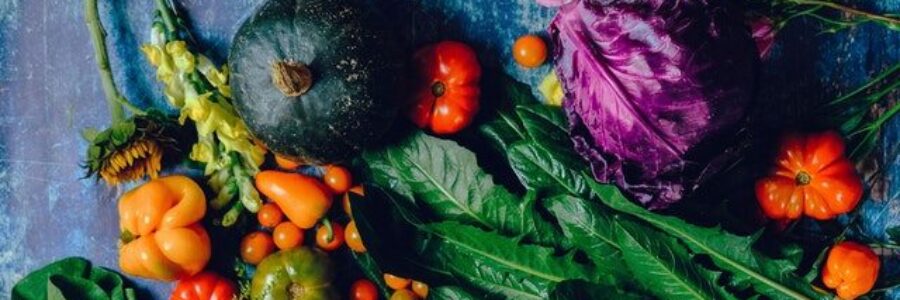In the west, we often look to the microbiome when trying to understand systemic conditions like eczema. We try limiting certain food groups like sugar, gluten, dairy or general inflammatory foods or load up on whole foods, pre- and probiotics to keep our eczema at bay. But most eczema sufferers will say that these changes don’t offer much change in their condition.
The TCM View
The Chinese view diet a little differently. While they also agree that maximizing real foods and minimizing processed foods is a good rule of thumb, in Traditional Chinese Medicine (TCM) the two most important qualities for food-as-medicine are heat and cold. These ideas don’t just pertain to the actual temperature of the food, but rather how that food moves energy within your body. This ability depends on numerous factors including at what point of development the food was harvested, the part of the plant or animal used, the way the meal was prepared and even where and how the food was raised and harvested.
How Foods Affect Your Body
When you eat cooling foods, the energy and fluids of the body are directed inward and downward so that the exterior and upper portions of the body cool first. In contrast, warming foods push deep energy and blood up and out to the surface of the body. You’ve probably noticed, when you eat cayenne peppers, you feel immediately warmer but then cool as the heat radiates out of your body. This concept explains why many eczema patients find that spicy foods and alcohol (warming foods) can make their skin suddenly flare up.
What makes a food warm or cool?
The Chinese observed that many factors affect the warming or cooling properties of food:
- Plants that take a longer time to grow are more warming than those that grow quickly (root veggies vs leafy veggies).
- Chemically fertilized plants foods, which are stimulated to grow faster, are often more cooling. This includes most commercially grown fruits and vegetables.
- Raw food is more cooling than cooked food.
- Food eaten cold is more cooling.
- Foods that are blue, green or purple are usually more cooling than foods that are red, orange and yellow.
- Cooking methods that involve more cooking time, higher temperatures and greater pressure (Instapot recipes, deep frying), dryness and/or air circulation (BBQ, baked goods) impart more warming qualities to food. Cooking for a long time in low heat is more warming than a short time in high heat (crock pot vs. stir fry). Heatless cooking that breaks down foods (fermenting, marinating and sprouting) makes that product progressively cooler.
- Finer cutting, pounding, grinding pressing and stirring breaks down food which then releases more energy and heat in the body.
- Chewing food more thoroughly creates warmth. Even cooling foods become warmer with more chewing.
How this pertains to Eczema
Most eczema patients will hear me say that they have too much heat in their body (Click this for more details). Therefore, the herbal treatment’s initial goal is to reduce heat or usher it out of the body. Something you can do at home to further promote heat reduction is to incorporate more cooling foods into your diet. Here is a list of the best cooling foods:
- Fruit: apple, banana, pear, persimmon, cantaloupe, watermelon, tomato, citrus
- Vegetable: lettuce, radish, cucumber, celery, button mushroom, asparagus, Swiss chard, eggplant, spinach, summer squash, cabbage, bok choy, broccoli, cauliflower, sweet corn, zucchini
- Legumes & Grains: soy milk, soy sprouts, tofu, tempeh, mung beans, alfalfa sprouts, millet, barley, wheat, amaranth
- Other: seaweeds, spirulina, wheat & barley grass, kudzu, yogurt, crab, clam,
- Herbs & Spices: peppermint, dandelion, honeysuckle, nettles, red clover, lemon balm, white peppercorns, cilantro, marjoram
Conclusion
If the foods you are eating are not on this list, chances are they are warming foods. That is not necessarily bad. If you have eczema and heat is a factor, try to balance your warm foods with cold foods in order to stay “temperature neutral” or lean towards eating more cooling foods to help reduce the heat in conjunction with your herbal formula. But don’t overdo it. TCM is all about coaxing the body back to normal function, gently. That’s what promotes lasting change.
Need Help with Eczema?
If you are looking for answers to eczema for yourself or a loved one, watch this video to learn more about herbal medicine and dermatology, and what a first consultation is like.
Want to Learn More?
Click Here for our free e-course “Healing Eczema Inside and Out,” and you will also receive our Amethyst Holistic Skin Solutions Newsletter. Both will give you interesting information about Traditional Chinese Medicine (TCM) and eczema via articles, before/after pictures, case studies of Amethyst Eczema patients. Feel free to click the icons below to share this article with someone who may benefit.
About the Author
Dr. Olivia Hsu Friedman, LAc, DACM, Cert. TCM Dermatology is the owner of Amethyst Holistic Skin Solutions and treats eczema patients via video conferencing using only herbal medicine. Olivia serves on the Advisory Board of LearnSkin, is the Chair of the American Society of Acupuncturists Board of Directors, and is a faculty member of the Chicago Integrative Eczema Support Group sponsored by The National Eczema Association.



